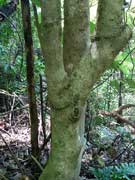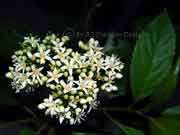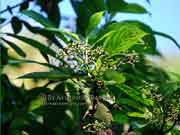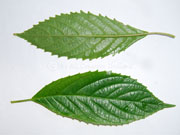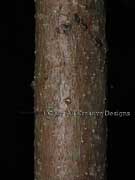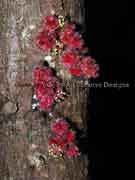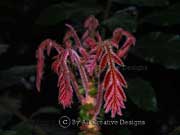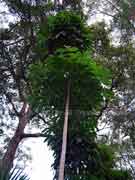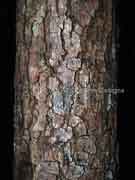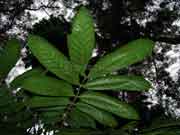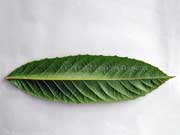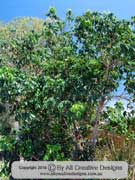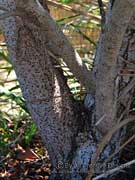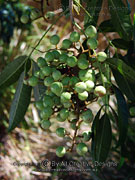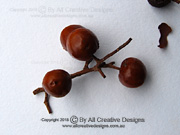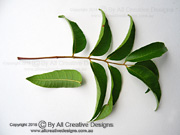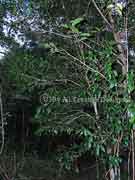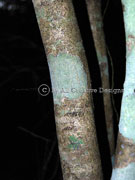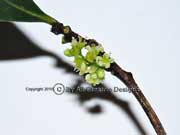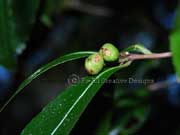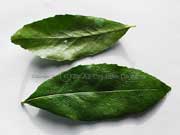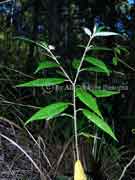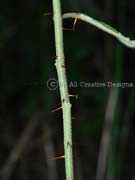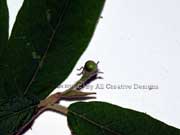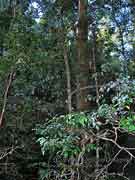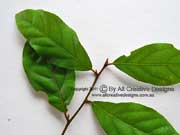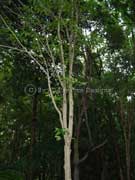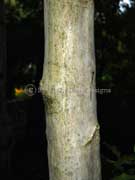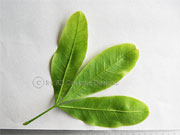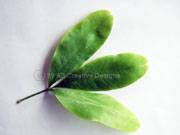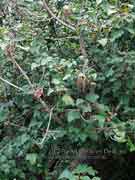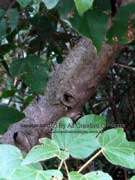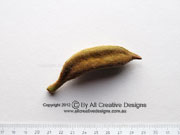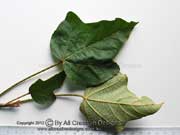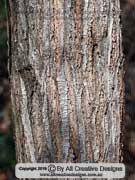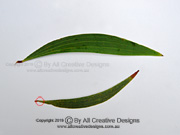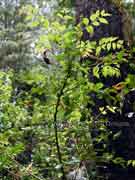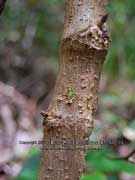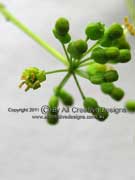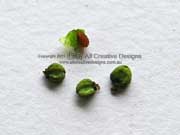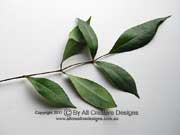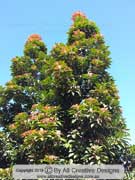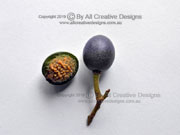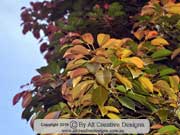
< Expand the Menu to access our Tree Identification Pages
Australian Tree Identification using Fruit Characteristics
Native tree and shrub pictures showing; fruit samples, full size specimens, leaf, bark and flower. The main types of fruits of Australian flowering trees are classified either as succulent berries and drupes or dry pods, capsules and follicles. The fruit identification web page: Fruit Characteristics explains botanical definitions of fruits. Detailed and comprehensive descriptions aiding in the identification are given for every tree species. The Rainforest of Australia's East Coast book lists tree species and display their fruit in printed format.
The image folder below is constantly extended and updated, find something new each time you visit our web site. Species in the following genera are listed in groups on our web pages: Australian Fig trees (Ficus spp.), Australian Eucalypts (Eucalyptus spp.), Grevilleas (Grevillea spp.) and Lilly Pillies/Satinashes (Syzygium spp.). Otherwise all native Australian tree species are listed in alphabetical order. Refresh the page in your browser to view updated content.
Camphor-scented Baeckea Triplarina volcanica
Camphor-scented Baeckea Triplarina volcanica
This attractive shrub reaches a height of 2.5m and is identified by its distinctive foliage. It has been reported to grow in heath environments within mountainous areas (Image 1). Bark is brown and stringy, fibrous in texture (2). One or two solitary flowers, supported by a short stalk (peduncle), emerge from leaf axils and reach a diameter of 5 to 6mm when fully opened. Flowers resemble Baeckea and Leptospermum species (Tea Trees) with 5 pure white and nearly rounded petals. Up to 16 stamens consisting of incurving white filaments and flattened light brown anthers surround the ovary in the centre. The 5 tiny sepals are oblong or more ovate (egg-shaped) and bluntly pointed at the apex (Image 3). The fruit is a capsule that hardens with maturity. It measures less than 3mm in diameter and 2 to 3mm in length. The 5 sepals (of the flower) persist at the top of the fruit (Image 4). The tiny simple leaves have a regularly spaced opposite arrangement. They are; up to 7mm long, oblanceolate (reverse lance-shaped) with entire margins, hairless, dull, dark green on both sides, thick, covered in surface glands and scented when crushed. The yellowish petiole (leaf stalk) is less than 2mm long and appressed to the stem. Distribution: Southern Qld. Note: Two subspecies T. volcanica subsp. volcanica (shown) and T. volcanica subsp. borealis. Baeckea camphorata is synonymous with Triplarina imbricata a rare species endemic to northern NSW.
Candelabra Wattle Acacia holosericea
Candelabra Wattle Acacia holosericea Other names: Silver-leaved Wattle
This very adaptable shrub has a wide distribution range and not only inhabits dry inland regions of northern Australia, but is also found in monsoonal rainforests. It is relatively short-lived and reaches a height of 4m (Image 1). Bark is greyish brown, rough and stringy in texture (2). Attractive flower spikes (not shown) are a deep yellow. Seedpods form a tangled mass and mature to a hard woody consistency before splitting to release seeds that are up to 5mm long with a conspicuous orange-coloured stalk (funicle) (3 & 4). The very attractive grey green leaves (phyllodes) feature 3 main longitudinal veins that are very conspicuous. Alternately arranged phyllodes are; up to 20cm long, elliptic or oblanceolate (reverse lance-shaped) with entire margins, the same colour green on both surfaces (concolorous), covered in fine whitish hair and firm in texture. A gland is visible at the base of the blade (5). Distribution: WA, NT, northern and central Qld.
Candlenut Aleurites moluccana
Candlenut Aleurites moluccana Other names: Candleberry, Indian Walnut, Kemiri, Kukui Nut Tree, Buah keras
Due to its wide distribution range throughout Asia and Oceania this medium tree species is known by numerous different common names. In its natural habitat of tropical rainforests, it can reach a height of up to 25m with a large spreading canopy (Picture 1). Bark is firm, grey brown in colour and densely covered in brown coloured blisters (lenticels) giving it a a rough texture (2). Flowers measure up to 15mm in diameter and feature 5 pure white and rounded petals. They are held on large panicles and flower over the winter months (in Australia) (3). The brown nut is covered in a hard shell reaching about 5cm across and can be eaten after roasting (toxic when raw). It contains flammable oil enabling the nut to burn for up to 20 minutes, hence the Australian name of Candlenut. The nut has also been used for a range of medicinal purposes (4 & 5). Large simple leaves with an opposite or sometimes alternate arrangement are; up to 25cm long, ovate in shape or feature 3 to 5 lobes, light green on top, paler beneath, slightly hairy below (along veins), rather thick and leathery in texture. Leaf apex (lobe apex) is acute, base shape is cordate. The stiff petiole is covered in fine hair and can be more than 25cm long. Venation is very prominent with a palmate arrangement on lobed leaves (5). Distribution: Tropical Qld.
Rainforests of Australia's East Coast, HAND SIGNED BOOKS; (In Stock) A practical and informative field guide to the identification of native rainforest species. More than 800 colour photographs, informative graphics, maps and detailed description of more than 300 species.
This book is a valuable information source for bushwalkers, students, gardeners and anyone with an interest in Australia’s native flora.
The book was written and illustrated by the author of the tree identification web pages.
New Holland Publishers: May 2025
ISBN: 9781760796921
Format: Paperback with PVC
Pages: 304 pp.
Size: 23 cm high x 15 cm wide
Full Colour Photography
Rainforests: Identification - Evolution - Reproduction
Dedicated photography of rainforest species including; mosses, mushrooms, lichens, slime moulds, ferns, conifers, flowering trees, climbing plants, orchids and palms enable the reader to identify commonly encountered species.
CLICK HERE FOR MORE INFORMATION
Candlenut Siris Aleurites rockinghamensis
Candlenut Siris Aleurites rockinghamensis
This species is a close relative to the Candlenut Aleurites moluccana (listed above) and was formerly classified as a subspecies of the above. Aleurites rockinghamensis is commonly found in upland and lowland tropical rainforests, and often a pioneer species in regrowth areas (1). Within a forest environment, it develops a straight trunk covered in a pale grey/brown bark showing longitudinal fissures (2). The mostly 3-lobed fruit can reach more than 8cm across and changes from green to brown at full maturity. It contains 3 rounded seeds which are enclosed in a brown hard shell. The fruit of Aleurites moluccana only contains a single (sometimes 2) seed(s) (3 & 4). Large simple leaves with an alternate (sometimes close to opposite) arrangement are; up to 40cm long, broadly ovate with entire margins (on mature trees), dark green on top, paler beneath, sparsely hairy, strong and firm in texture. Leaf apex is acute ending in a fine tip, base shape is cordate. Venation is semi-palmate and raised on both surfaces. The 2 prominent oblong shaped glands (inset) at the apex of the leaf stalk are a good identification feature. They are green on younger and change to black on older leaves. The strong and rigid petiole is up to 20cm long (5). Distribution: Tropical north QLD.
Cape Tamarind Diploglottis macrantha
Cape Tamarind Diploglottis macrantha
This tall shrub or small tree can reach a height of up to 6m and inhabits tropical rainforest as an understorey species. The foliage consists of distinctive large compound leaves (Image 1). Bark is coloured different tones of grey with a hard and fairly smooth texture (2). The fruit is a yellowish to orange coloured capsule with 3 or 4 valves (segments), each containing a seed covered in a fleshy orange aril (3). Large pinnate compound leaves consist of up to 16 leaflets, which are; up to 30cm long, oblong to broad elliptical in shape with entire margins, bristly hairy and firm in texture. Lower leaflet surface is a paler yellowish green colour with a reddish brown centre vein. Leaf and leaflet stalks are covered in rusty brown hair (4 & 5). Distribution: North Qld.
Cape Tamarind Toechima daemelianum
Cape Tamarind Toechima daemelianum
Confusingly, the common name Cape Tamarind is also used for Diploglottis macrantha (shown above). This tall shrub or small tree is identified by its attractive foliage consisting of large pinnate compound leaves. It reaches a height of about 10m and is found growing beneath taller trees in tropical gallery rainforests, a type of rainforest that is confined to the banks of watercourses (Image 1). The grey coloured bark is firm and apart from small horizontal ridges rather smooth (2). Bisexual flowers are borne on panicles that are up to 30cm long (ofen shorter) and emerge towards the end of young branches. Flowers measure less than 10mm across and feature 5 white and rounded petals. The eight well-defined stamens consist of white and hairy filaments crowned by light green coloured anthers. Stamens surround a prominent and hairy ovary in the centre (3). Pinnate compound leaves reach a length of more than 30cm and normally feature 8 (sometimes 6 or 10) leaflets. They are: up to 14cm long, lanceolate (lance-shaped) or elliptic, hairless when mature, firm and strong in texture. Leaflet margins with large rounded teeth have a wavy (undulating) appearance. Small swellings (domatia) are visible along the centre vein, but may not be present on every lower leaflet surface (4 & 5). Distribution: North east Qld and Cape York. Locate related species under the genus Toechima on the botanical species list.
Cape York Tulipwood Harpullia ramiflora
Cape York Tulipwood Harpullia ramiflora Other names: Claudie Tulipwood
The natural habitat of this attractive tall shrub is lowland tropical rainforest, where as an understorey species it prefers locations close to watercourses (Image 1). Bark is grey in colour, firm and finely rough due to a dense cover of lenticels (blisters) (2). The ornamental fruit is a capsule opening into 2 separate valves, each containing a black seed covered in a yellow aril. The capsule is a vivid red colour and measures close to 2cm in length. The base of the flower (calyx) remains with the fruit to full maturity (3). The dense and drooping foliage is made up of large pinnate (once divided) compound leaves featuring up to 11 leaflets, showing an alternate arrangement (4). Leaflets are; up to 40cm long, oblong to oblanceolate (reverse lance-shaped) with undulating (wavy) margins, hairless, rather glossy and smooth on both surfaces. Midrib, lateral and net veins are clearly visible on lower leaflet surface (5). Distribution: Cape York Peninsula, North Qld.
Casearia Casearia multinervosa
Casearia Casearia multinervosa Other names: Claudie Tulipwood
This handsome shrub or small tree reaches a height of less than 10m and inhabits dry subtropical rainforests as an understorey species. The neatly arranged leaves that are borne on zigzag shaped branches and the distinctive bark are identifying features (Image 1). Bark at the base of older trunks is shades of grey and densely covered in rounded protrusions (2). Flowers are borne in compact clusters along younger branches. They feature rounded petals and sepals 2 to 3mm long that finely hairy. Normally 8 stamens surround the green glabrous (hairless) ovary in the centre. Stamens feature white filaments topped by prominent brown anthers (when mature). The yellow appendages between stamens are referred to as staminodes (infertile stamens) (3). The young branches are often zigzag shaped and marked by whitish protrusions (lenticels). The alternately arranged and regularly spaced (2-ranked) simple leaves are; up to 10cm long, mostly elliptic in shape with entire margins, hairless, very similar green on both surfaces, strong and leathery. Venation is clearly visible on upper leaf surface (4 & 5). Distribution: Coastal ranges of far northern NSW and southern Qld.
Cassia Senna acclinis
Cassia Senna acclinis Other names: Brush Senna, Rainforest Senna
This native shrub is rare due to habitat destruction and the invasion of other exotic Senna species. It is (mostly) a single stemmed shrub less than 5m high, which is found in a range of different forest types (Picture 1). The slender trunk features a dark brown coloured bark with fine fissures and a slightly rough texture ( 2). Bright yellow flowers are up to 20mm across and bloom over a long period throughout the year. They feature 5 stalked and obovate (reverse egg-shaped) petals characteristic for the genus (3). The fruit, a pod, is up to 18 cm long, flattened and mostly straight in shape. It contains up to 30 shiny brown seeds about 5mm long (4). Pinnate (once divided) compound leaves consist of up to 14 leaflets, which are; up to 5cm long, mostly elliptic in shape with entire margins, oppositely arranged, mid-green in colour on top, light green below, mostly hairless, thin and soft in texture. Leaflet apex is bluntly acute to rounded, base shape is rounded. A stalked gland (inset) is visible at the junction of the lowest pair of leaflets with the grooved rachis (5). Distribution: NSW central coast to central Qld. Note: In identification the most obvious difference is the flattened seed pod of this native species compared to the rounded pod of the introduced Winter Senna or Easter Cassia (Senna pendula, view Introduced Species) and the Smooth Cassia (Senna septemtrionalis). View Leaf Characteristics Page for explanations of botanical terms used.
Cassowary Plum Cerbera floribunda
Cassowary Plum Cerbera floribunda Other names: Grey Milkwood, Babai, Rubber Tree
The Cassowary Plum is able to attain a height of 30m in its natural habitat of tropical rainforests at lower altitudes. The foliage, consisting of narrow long leaves held towards the end of young branches, gives the canopy its characteristic appearance, which can be helpful in the identification of this species (Picture 1). Bark at base of the trunk is a reddish brown in colour and features longitudinal ridges (2). The vivid blue coloured fruit is egg-shaped and up to 12cm long. It is a food source for the Southern Cassowary (Casuarius casuarius), giving the species its common name, but it is reported to be toxic to humans (3). Simple leaves, arranged in a spiral like fashion, are; up to 30cm long, oblanceolate with undulating (wavy) margins, hairless, highly glossy on both surfaces with a smooth and polished like texture. Leaf apex is short acuminate, base shape gradually tapers (attenuate). The petiole is up to 5cm long and emits a white sap when broken (5). Distribution: Tropical northern Qld.
Cassowary Pine Barringtonia calyptrata
Cassowary Pine Barringtonia calyptrata Other names: Mango Pine, Corned-beef Wood
The Cassowary pine is a very attractive tree that is able to reach a height of up to 20m within lowland tropical rainforests. It can also be found in close proximity to the coast and along waterways. Large leaves forming a whorl at the end of young branches are an identification feature. This tree is deciduous or semi-deciduous in late winter to early spring. In the image, the higher part of the trunk is host to a large Basket Fern (Picture 1). Bark on mature trees is somewhat scaly and sheds in irregular sized plates exposing the fresh light brown coloured bark. Texture is relatively soft and fibrous (Picture 2). Up to 60 individual flowers are borne on a spike that reaches a length of 60cm. The flower features a white corolla which splits into 4 lobes to reveal numerous white stamens and a longer white style in the centre (Picture 3). The fleshy and abundantly produced fruit turns a greyish blue when fully ripe and is reportedly eaten by the Cassowary (Casuarius casuarius). The fleshy fruit (a drupe) is ovoid (reverse pear-shaped) or spindle-like (broadest in the middle), up to 10cm long and contains a single seed. The remaining flower style is visible at the apex of the fruit (Picture 4). Simple leaves with entire margins are arranged in a whorl formation. They are; up to 35cm long, oblanceolate (reverse lance-shaped) or more obovate (reverse egg-shaped), dark green and smooth on top, strong and leathery in texture. The petiole (leaf stalk) is up to 3cm long and emits a small amount of white sap when broken (Picture 5). Distribution: Tropical NE Qld.
Celery Wood Polyscias elegans
Celery Wood Polyscias elegans Other names: Silver Basswood
For a rainforest species the Celery Wood is rather fast growing and can reach a height of 30m. It is distinguished by its elegant foliage made up of large, glossy compound leaves forming an umbrella-like shape at the end of branches (Picture 1). Especially the bark, among other parts of the tree, has a celery-like odour when rubbed and is beige to grey in colour. On older trees it becomes deeply furrowed with a very hard and brittle texture in dry periods (2). The fruit (a drupe) turns a very dark purple to nearly black in colour when fully ripe, measures about 5mm in diameter and is flattened and rounded in shape. Fruit ripens over autumn into winter (3). Large pinnate or sometimes bi-pinnate compound leaves can measure more than 50cm in length and feature up to 13 leaflets, which are; up to 12cm long, mostly ovate in shape with entire margins, hairless, dark green, very glossy on top, paler green and also glossy beneath, faintly celery-like scented with a very smooth and polished-like texture. Leaflet apex is short acuminate ending in a fine point, base shape broadly cuneate to rounded. Petiolule (leaflet stalk) is up to 10mm long. Venation is fine but clearly visible on both surfaces (4 & 5). Distribution: From southern NSW to north Qld.
Chain Fruit Alyxia ruscifolia
Chain Fruit Alyxia ruscifolia
This native shrub has a wide distribution range and grows to height of 4m. It occurs in most types of rainforests (Picture 1). Bark is a mid brown to olive-green in colour with a flaky texture (2). Beautiful white flowers feature 5 fused petals forming a cylindrical floral tube (reddish-brown), which separates into 5 lobes at the top. Flowers are up to 2.5cm long and less than 1cm in diameter at the apex. They are held in tight clusters of up to 10 individuals at the very end of branches (3). The unusual fruit is fleshy, roughly globose (globe-shaped), bright orange-red in colour and about 10mm in diameter. It can be single or nearly fully divided into 5 segments (chain-like) giving this native species its common name and contains a hard seed in each segment (4). The simple leaves are held in a whorl arrangement of up to 6 (mostly 4) and exude a white sap. Leaves are; up to 7cm long, mostly ovate (egg-shaped) with entire margins, dark green and glossy on top, paler beneath with a stiff and slightly rough texture. Leaf apex is acute ending in a very sharp spine, base shape is cuneate. Lateral veins are broad and raised on upper leaf surface (5). Distribution: From NSW south coast to northern Qld.
Descriptions and all images copyright ©2025 by www.allcreativedesigns.com.au world wide rights reserved.
Click Images for Full Size View
Cheese Fruit Morinda citrifolia
Cheese Tree Morinda citrifolia Other names: Noni Fruit, Indian Mulberry, Great Morinda, Beach Mulberry, Rotten Cheesefruit
This extremely adaptable shrub or small tree (6 to 8m) is able to withstand harsh and salty conditions in exposed dry coastal environments or can grow under deep shade as an understorey species in tropical and monsoonal rainforests. Multiple trunks and distinct foliage consisting of large leaves that cluster towards the end of young branches are common features. The common name refers to the putrid cheese-like odour of the ripe fruit (Image 1). Bark is brown and on older trunks becomes furrowed (grooved) and scaly with a corky texture (2). The flower head consist of multiple fused carpels (ovary, style and stigma; female reproductive parts of a flower), each featuring a greenish white trumpet-shaped corolla (fused petals) that separate into 5 pointed lobes at the apex. The corolla tube is about 6 to 8mm long, lobes normally slightly shorter when fully opened (3). The fleshy compound fruit (syncarp) is irregularly shaped and can reach a length of more than 15cm. It turns yellowish white, soft and foul smelling when fully ripe, and contains numerous flattened brown seeds (4). Young leaves form loose whorls at the end of branches and turn opposite thereafter. They are; simple, up to 25cm long (larger under shady conditions), broadly elliptic or oblanceolate (reverse lance-shaped) with broadly undulating (wavy) or entire margins, hairless, glossy, firm and strong (5). Natural distribution: Central to northern Qld, NT and WA (Asia). Note: This species is reported to have medicinal properties and has been used by humans for more than 2000 years. It is an invasive plant. 2 variations are recognised.
See
Leaf -
Flower - Fruit - and Bark Identification Web Pages for explanations of botanical definitions and concepts.
Select images for Full Size View. (Opens new browser window).
Use the Key to Species, which is based on leaf characteristics, to identify native trees and shrubs found on Australia's east coast.
Cheese Tree Glochidion ferdinandi
Cheese Tree Glochidion ferdinandi Other names: Buttonwood
This medium sized tree with a compact and rounded canopy reaches less than 20m in height. It is a common occurrence along watercourses, within different types of rainforests and also in tall open forests (Pictures 1 & 2). Bark is light to medium brown, weathering to grey and has a hard, rough and fissured texture (3). The fruit, a capsule, varies from light green to red in colour when mature. It measures up to 2cm across and features a number of lobes (segments), each containing a small seed that is covered in a red aril (skin). (4). Simple leaves with an alternate leaf arrangement (mature trees) are; up to 10cm long (leaves are considerably larger on saplings), elliptic to oblong in shape with entire margins, hairless, dark green and glossy on top, paler but shiny below with a smooth and soft texture. Apex is short acuminate, base is cuneate and sometimes asymmetric (5). Distribution: From NSW south coast to central Qld. Note: Excellent species for riverbank regeneration work; roots exposed by floods will produce new shoots.
Coachwoood Ceratopetalum apetalum
Coachwood Ceratopetalum apetalum
The Coachwood is a medium size tree growing to a height of 30m. It is found mainly at higher altitudes in cool and warm temperate rainforests, but sometimes also in cooler forms of subtropical rainforests (Pictures 1). Bark at the base of older trees becomes rough, fissurred and scaly. Whereas bark on the higher trunk is relatively smooth, greyish white with a firm texture and horizontal markings. Buttress roots and coppice shoots develop on mature specimen (2 & 3). Simple leaves with an opposite leaf arrangement are; up to 14cm long, elliptic to oblong in shape with finely toothed margins, hairless, firm and leathery in texture. Leaf apex is short acuminate, base shape is cuneate. Mid vein is raised and yellow coloured on lower leaf surface, otherwise venation is faint (4). The petiole (leaf stalk) has a prominent pulvinus (swelling) at the base and is up to 2cm long. Horizontal scars on young branches are caused by fallen stipules (5). Distribution: from the NSW South coast to central Qld. See Leaf Characteristics Page and Bark Identification Page for more information on definitions used.
Coast Banksia Banksia integrifolia ssp. integrifolia
Coast Banksia Banksia integrifolia ssp. integrifolia
In more sheltered positions, the Coast Banksia is able to reach a height of 15m, whereas in exposed coastal locations, it is often a windblown and twisted shrub less than 5m high ( Picture 1). Bark on older specimens is light grey in colour, deeply fissured and firm in texture (2). Pale to bright yellow flower spikes are up to 10cm long and bloom over the warmer months of the year (3). Picture 4 shows the dehiscent fruit (after opening) to the left and in its early development after flowering to the right (4). Up to 6 simple leaves form a whorl below the growing bud, turning to an alternate arrangement thereafter. Leaves are; 8 to 10cm long, mostly broadly oblanceolate (reverse lance-shaped) with entire (toothed in juveniles) and incurved margins, dark green and hairless on top, light grey to nearly white and finely hairy below, firm and leathery in texture. Leaf apex is rounded, base shape is attenuate. Mid vein is prominent and a yellow colour, numerous straight lateral veins are rather faint (5). Distribution: Common species in Tasmania, Vic., NSW and Qld. See also White Mountain Banksia (B. integrifolia ssp. monticola) Page 12.
View: Flower Characteristics Page and Leaf Characteristics Page for information on terms used.
Green Guide Trees of Australia
How to recognise Australian tree families and genera.
A practical field guide to the identification of native species. More than 200 full colour photographs and detailed descriptions explaining leaf, bark, flower, fruit and other tree characteristics. The guide was written and illustrated by the author of these web pages.
New Holland Publishers: January 2016
Format: Paperback with PVC
Pages: 128 pp.
Size: 13 cm wide x 18 cm high
First Edition, Hand Signed Copies
CLICK HERE FOR MORE INFORMATION Coast Beard Heath Leucopogon parviflorus
Coast Beard Heath Leucopogon parviflorus
This tall shrub attains a height of up to 5m and is often part of the first vegetation growing behind sand dunes along the shoreline. It often shares this habitat with the Coastal Tea Tree (Leptospermum laevigatum, listed below on this page) (Picture 1). Bark is brown in colour and features fine ridges, giving it a finely rough texture (2). The fleshy fruit (a drupe) is globose (globe-shaped) and measures up to 4mm in length. It changes to a milky white colour at full maturity (3). Branchlets (young branches) are clothed in very fine, whitish hair (4). Simple leaves with an alternate arrangement are; up 3cm long, oblanceolate (reverse lance-shaped) with entire margins, hairless, rather thick and strong. Leaf apex is rounded with a tiny tip (mucronate), base gradually narrows. Petiole (leaf stalk) is very short or absent. Longitudinal venation is visible on upper surface with normally 3 veins being more pronounced (5). Distribution: Widespread along Australia’s east coast.
Coast Cypress Pine Callitris columellaris
Coast Cypress Pine Callitris columellaris
As the name suggests this native conifer in the family CUPRESSACEAE occurs on sandy soils in proximity to the coast. Under suitable conditions it grows to 25m tall and has a characteristic dark green and dense canopy supported by an upright trunk, even in areas regularly exposed to high winds. In the field it is impossible to distinguish this species from the White Cypress Pine (C.glaucophylla), except for location as the later species occurs in drier inland areas. Some botanists classify these different taxa as variations or subspecies. (Source: http://www.conifers.org/cu/Callitris_columellaris.php) (1). At the base of the trunk bark is charcoal grey to nearly black in colour and has a very rough fissured texture (2). The woody seed cone varies in size from 12 to 25mm in diameter and consists of 6 relative thin and rough cone scales that widely open to release the seed. The brown stiff and non-transparent papery wing(s) enclosing the seed is irregular in shape and up to 5mm long (3 & 4). On mature trees whorls of 3 tiny scale-like leaves appear at short internodes and are only up to 3mm long. They are sharply pointed at the tip and rounded on their backside without are ridge (not keeled). Colour can vary from deep dark green to a bluish grey green (glaucous), probably depending on available moisture (5).
Distribution (as subspecies or variations): SA, Vic., NSW, Qld, NT & WA. See also Port Jackson Cypress Pine (C.rhomboidea) Page 8.
Coastal Rosemary 'Wynyabbie Gem' Westringia fruticosa x eremicola
Coastal Rosemary Westringia fruticosa x eremicola
As the common name suggest this native shrub bears a resemblance to the culinary herb, but does not contain any aromatic oils. The images show the cultivar 'Wynyabbie', a hybrid of W.fruticosa (Coastal Rosemary) and W.eremicola (Slender Western Rosemary or Slender
Westringia), an inland species. This cultivar is a single-stemmed sturdy shrub able to reach a height of 2m and is widely used as an ornamental plant (Picture 1). Bark is greyish brown in colour with distinct longitudinal ridges (2). The flower corolla of this cultivar is pale mauve to pink with brownish dots in the centre, whereas W.fruticosa is white and W.eremicola is mauve or purple (3). Leaves of this cultivar typically appear in whorls of 4, as is the case for W.fruticosa. Leaves of W.eremicola are arranged in a whorl of only 3, but are the same length (about 2cm) and linear to more narrow elliptic in shape, thereby resembling this cultivar (4 & 5). Natural distribution: W.fruticosa; often in close proximity to the coastline in NSW. W.eremicola; in dryer inland areas of SA, Vic., NSW and Qld.
Coastal Tea Tree Leptospermum laevigatum
Coastal Tea Tree Leptospermum laevigatum
The Coastal Tea Tree is a tall native shrub or small tree reaching a height of 6m or more. Its ability to tolerate strong salt spray makes it a common sight in coastal locations. Older specimens are multi trunked and with a spreading habit can form dense stands, which are often part of the first vegetation behind sand dunes (Picture 1). Bark is rough and stringy in texture shedding in long strips. It is cream coloured when newly exposed changing to a grey-brown with maturity (2). White flowers measure between 15 to 20mm in diameter and bloom late winter to spring (3). The fruit is a dry woody capsule up to 5mm in diameter, which is seated on a stalk 3 to 4mm long. It splits at the apex to release numerous fine seeds and detaches soon thereafter (4). Small simple leaves with an alternate arrangement are; up to 25mm long, mostly oblanceolate (reverse lance-shaped) with entire margins, hairless, grey-green, rather dull on both surfaces and firm in texture. Apex is rounded with a very small tip (mucronate), leaf base shape is attenuate. Petiole (leaf stalk) is only 1 - 2mm long and yellow-brown in colour. Venation is faint, but 3 longitudinal veins are more obvious (Picture 5). Distribution: Widespread in coastal areas of Tasmania, South Australia, Victoria, NSW and Qld.
Coffee Bush Breynia oblongifolia
Coffee Bush Breynia oblongifolia Other names: Dwarf Apple
This very adaptable species has an extensive distribution and inhabits environments ranging from coastal rainforests, including the tropical form, to semi-arid inland regions. It is a sturdy and densely branching shrub that can reach a height of 3m. The foliage is a distinguishing feature (Image 1). Bark at the base of older trunks is brown, rough and flaky (2). The succulent fruit is a rounded berry up to 6mm in diameter which is pink or more orange in colour and turns black when fully ripe (3). The foliage consists of small leaves that are evenly spaced (2-ranked) along the reddish brown and zigzag shaped branchlets (4). Simple leaves with an alternate arrangement are; up to 3cm long, ovate (egg-shaped) with entire margins, hairless, dark green on top, paler green beneath, relatively thin and soft. The rounded leaf apex often features a tiny tip (mucronate). Petiole (leaf stalk) is less than 3mm long. Pinnate venation is rather faint. Distribution: VIC/NSW border to north Queensland. Note: This species is similar in appearance to Gunn’s Phyllanthus (Phyllanthus gunnii) Page 6 G, but does not resemble a ‘true’ Arabian Coffee Bush (Coffea arabica), (View Invasive Species).
Common Acronychia Acronychia oblongifolia
Common Acronychia Acronychia oblongifolia
The natural habitats of this wide spread shrub, or small to medium sized tree, include open Eucalypt dominated forests, different types of rainforests and their margins. It also appears as a pioneer species in regrowth after clearing (Picture 1). Bark is firm, finely fissured and light brown in colour (2). The bright white coloured fruit measures up to 15mm in diameter. It features 4 distinct lobes, each containing one or two brown seeds (3). Simple (1-foliolate) leaves with an opposite arrangement are; up to 12cm long, oblong to obovate with entire margins, hairless, very glossy on both sides with a firm smooth texture and give off a pleasant scent when crushed. Leaf apex is rounded or notched, base shape is mostly cuneate (4). Petioles (leaf stalks) can be up to 3cm long and feature distinct joints (5). Distribution: Vic., NSW to central Qld.
Coogera Arytera divaricata
Coogera Arytera divaricata Other names: Rose Tamarind
The brightly pink to salmon coloured new growth is a distinctive characteristic of this rainforest tree species. Within subtropical rainforests, it is able to reach more than 20m in height (Picture 1). Bark is a light to mid grey in colour with a firm and finely rough texture (2). The fruit, a capsule, is about 1cm long and features 1 to 3 nearly separated segments (lobes). Each lobe contains a brown coloured seed, which is partly covered by a red fleshy aril (turning black when exposed) (3). Pinnate (once divided) compound leaves consist of up to seven leaflets, four are most common (4). Leaflets are; up to 14cm long, elliptic to obovate (reverse egg-shaped) with entire margins, dark green, glossy when mature, vivid pink when emerging, strong and rather rough in texture. Venation is clearly visible on both leaflet surfaces, small hollow domatia are present along the centre vein (5). Distribution: NSW central coast to north Qld.
Corkwood Duboisia myoporoides
Corkwood Duboisia myoporoides Other names: Duboisia
The Corkwood or Duboisia grows on the margins or within different types of rainforests and reaches a height of up to 20m (Picture 1). Crooked trunks feature a very deeply furrowed and soft corky bark, which is light brown in colour with grey and cream coloured patches (2). Small white flowers with five rounded and frilled petals reach less than 1cm in diameter and are arranged on large panicles, which appear at the very end of young branches. Main flowering period is late winter and spring (3). The rounded to slightly ovoid shaped fruit, a berry, turns black when fully mature. It measures 5 to 6mm across with the remaining (flower) calyx visible at the base of the fruit (4). Simple leaves with an alternate arrangement are; up to 13cm long, elliptic or oblanceolate (reverse lance-shaped) with entire margins, greyish dull green, hairless and soft in texture. Leaf apex is acute ending in a fairly blunt point, base shape is attenuate. Venation is only faintly visible, but the centre vein is prominently raised (5). Distribution: NSW south coast to central Qld.
Crabapple Schizomeria ovata
Crabapple Schizomeria ovata Other names: White Birch
This species is normally a medium sized tree up to 25m high, occurring within subtropical rainforests and other forest types, but more exceptional specimens can attain a height of up to 40m (Picture 1). Bark is very firm and fissured on the lower trunk of older specimens and shades of grey in colour (2). The globose (globe-shaped) fruit (a drupe) is white to pale yellow coloured and measures up to 2cm in diameter. The white fruit flesh emits an apple-like scent when crushed and contains a single seed enclosed in a hard shell (3). Simple leaves with an opposite arrangement are; up to 16cm long, oblong to ovate (egg-shaped), hairless, glossy and feature leaf margins which are very varied from finely toothed to nearly entire. Petiole (leaf stalk) is up to 3cm long with a pronounced joint at the stem (4). Stipules, enclosing the growth bud, are up to 5mm long and leave a horizontal scar on the young branch after detaching. Mid vein is prominently raised and a yellowish colour on lower leaf surface, curved lateral veins are clearly visible (5). Distribution: From the NSW south-coast to southern Qld.
Crimson Bottlebrush Callistemon citrinus
Crimson Bottlebrush Callistemon citrinus
This handsome native shrub with a wide distribution range is a common occurrence near the coastline and in low lying areas, where it prefers moist locations. It can reach up to 4m in height, often with a straggling growth habit, using other vegetation for support where possible (Photo 1). Bark on mature specimens is rough, flaky and especially around the base rather soft in texture; colour is mid-brown (2). Crimson flower spikes have a bottlebrush-like appearance and measure up to 15cm in length. Individual flowers are dominated by numerous filaments topped by small black anthers and bloom over a long period from spring into autumn (3). The cup-shaped fruit measures up to 6mm in diameter, turns woody when fully mature and is stalk-less. Valves at the top of the capsule open to release a great amount of very fine, brown coloured seeds, which are light enough for aerial dispersion. Old capsules that will not detach, but remain on branches for years are a good identification feature (4). Mature simple leaves with an alternate arrangement are; up to 8cm long, oblanceolate in shape with entire margins, same colour green on both surfaces (concolorous), hairless, lemon-scented when crushed, strong and rigid in texture. Leaf apex is acute, base gradually narrows into the petiole, which is a yellowish colour and only 2 to 3mm long. Midrib is yellowish on the underside, oil glands are clearly visible and an intramarginal vein is present (5). Distribution: Vic., NSW and Qld.
See
Leaf -
Flower - Fruit - and Bark Identification Web Pages for explanations of botanical definitions and concepts.
Select images for Full Size View. (Opens new browser window).
Use the Key to Species, which is based on leaf characteristics, to identify native trees and shrubs found on Australia's east coast.
Cudgerie Flindersia schottiana
Cudgerie Flindersia schottiana Other names: Silver Ash, Bumpy Ash
The Cudgerie or Bumpy Ash is a tall and upright native tree capable of reaching a height of 50m. It naturally occurs within subtropical and tropical rainforests or on their margins. This species is also regularly found in regrowth areas, where it outgrows most other species to form the highest canopy (Photo 1). Bark is shades of light grey in colour with a firm texture. The trunk retains large burls (Bumpy Ash) where old branches have detached (2). A splendid display of white scented flowers (turning yellow with maturity) can be seen over late spring and early summer. Flowers are held on large terminal panicles, with individual flowers measuring less than 1cm in diameter (3). The fruit is a very hard green capsule up to 12cm long. It is covered in stout and very sharp spikes (rasp-like). On maturity it will split into 5 boat-shaped segments releasing a number of small flattened seeds, each one being enclosed in an irregular shaped papery wing ideal for aerial dispersion (Photo 4 & Inset). Large pinnate (once divided) compound leaves feature up to 19 separate leaflets, which are; up to 20cm long, narrow oblong or slightly elliptic in shape with entire margins, dark green, hairless on upper surface and covered in fine hair beneath. Leaflet apex is acute, base shape is rounded and asymmetric. Venation is prominent on both sides with the mid vein and laterals being raised on the lower leaflet surface (5). Distribution: NSW mid-north coast to northern Qld.
Currant Tree Antidesma bunius
Currant Tree Antidesma bunius
This species has a wide distribution range throughout Asia and occurs naturally in drier tropical rainforests of north-eastern Queensland. Depending on conditions and location it can be a tall densely foliated shrub or a tree up to 25m tall (Picture 1). Bark on the trunk is rough, flaky and fissured; it weathers from a pink under-layer of fresh bark to dark brown then grey before shedding in irregular patches (2). The fleshy fruit, a drupe packed into elongated bunches (former flower racemes), is up to 20mm long and roughly ovoid in shape. It changes from red to black when fully ripe and contains a hard-shelled light brown seed. The sour but edible fruit is used to produce jams and wine (Pictures 3 & 4). Simple leaves with an alternate arrangement are; up to 14cm long, broadly elliptic or more obovate (reverse egg-shaped) with entire margins, dark green, hairless on top, paler green beneath and leathery in texture. Domatia in the shape of bristles are visible along the centre vein on the lower leaf surface. The short petiole (leaf stalk) and young stems are covered in fine brown hair. Distribution: North-eastern Qld.
Cut-leaved Mint Bush Prostanthera incisa
Cut-leaved Mint Bush Prostanthera incisa
When in full flower over spring this normally inconspicuous shrub becomes very noticeable. It prefers sheltered positions on the margins of rainforests or in wet tall forests (wet sclerophyll forests) at higher altitudes. Under favourable conditions it may reach 3m in height with a spreading canopy more than 2m wide (Picture 1). Bark is brown in colour with a firm and finely rough texture, due to fine ridges and blisters covering the surface (2). Masses of violet flowers measure up to 1cm in diameter when fully opened. They feature a distinctive two-lipped (2 lobed) calyx (flower base) and a corolla that is divided into 5 rounded lobes at the apex, attributes that are characteristic for this large genus (3 & 4). Simple leaves with an opposite arrangement are; up to 4cm long, lanceolate (lance-shaped) or more ovate with irregular toothed margins (up to 4 teeth on each side), hairless, dark green on top, pale green beneath, soft in texture and emit a very strong mint/menthol like scent when crushed. A dense cover of surface glands is visible without a lens (5). Distribution: Vic., NSW, & Qld. Note: This species is used in cultivation and produces an essential oil.
Cuttsia Cuttsia viburnea
Cuttsia Cuttsia viburnea Other names: Native Elderberry
The Cuttsia is a small understorey tree growing to a height of 15m within or on margins of subtropical and warm temperate rainforests (Picture 1). The pale grey bark on older specimens is soft and corky in texture with blisters and ridges being present ( 2). Attractive white flowers with a yellow centre are very pleasantly honey scented. They are borne on tightly packed panicles and bloom over spring and early summer (3). Abundant fruit in the shape of small rounded capsules ripens over summer. Fruit measures up to 5mm in diameter and is green to light brown in colour (4). Simple leaves with an alternate arrangement are; up to 20cm long, broad elliptic to obovate (reverse egg-shaped) with finely toothed margins, bright green and glossy on top, pale green beneath, hairless, thin and very soft in texture. Apex is acute to short acuminate, base shape is cuneate. Petiole (leaf stalk)is up to 20mm long. Mid vein and prominent curved laterals are sunken on upper leaf surface and strongly raised below (5). Distribution: Mid-north coast of NSW to southern Qld.
Davidson's Plum Davidsonia jerseyana
Davidson's Plum NSW Davidsonia jerseyana
This small native tree is cultivated for its edible fruit, but is very uncommon in its natural habitat of subtropical rainforests. Mature specimens have a straight slender trunk, which is only sparsely branched and can attain a height of 12m (Picture 1). Bark is brown in colour showing warty blisters and small ridges, texture overall is firm (2). Red flowers appear on the trunk of the tree and bloom from late winter into spring (3). Striking red coloured new growth is covered in prickly stiff hair, which can cause irritation to the skin when touched (4). Large pinnate compound leaves can be more than 80cm long and feature 15 (sometimes more) leaflets, which are; up to 30cm long, oblong or slightly oblanceolate (reverse lance-shaped) with toothed margins, mid green, white hairy on top, covered in stiff brownish hair beneath (especially on veins) and firm in texture. Apex is short acuminate and base shape is rounded. Mid vein and laterals are raised and covered in prickly beige to brown coloured hair on the leaf's underside (5). Distribution: Confined to few valleys in the Northern Rivers area of NSW. Identification: Very similar to Davidsonia pruriens but this species differs in bark texture and being prickly hairy. See Flower Characteristics Page and Leaf Characteristics Page for information on terms used.
Davidson's Plum Qld Davidsonia pruriens
Davidson's Plum Qld Davidsonia pruriens
Originating in tropical rainforests, this tree species with a slender and upright trunk reaches a height of 15m (Image 1). Bark is brown in colour with a scaly and flaky texture (2). Vivid blue fruits, reassembling a plum, are up to 6cm long and contain one or two flat and rounded seeds, embedded in the dark red fruit flesh (3). Large pinnate compound leaves with an opposite arrangement are more than 100cm long. They consist of up to 17 leaflets which increase in size from the bottom upwards. They are; up to 20cm long, oblong to oblanceolate (reverse lance-shaped) with regularly toothed margins and feature leafy stipules at the base of the petiole. Venation is prominent with centre and lateral veins being raised on lower leaflet surface and covered in soft whitish hair (4 & 5). Distribution: Northern Qld. Note: This species and Davidsonia jerseyana were classified as subspecies in the past.
Deep Yellowwood Rhodosphaera rhodanthema
Deep Yellowwood Rhodosphaera rhodanthema Other names: Tulip Satinwood
Under optimum conditions, mature trees are able to reach a height of more than 20m, but under less favourable conditions they will flower and produce fruit when relatively young and only shrub size (4 to 5m). Preferred habitats include dry and subtropical rainforests from coastal to mountainous location. The common name refers to the dark yellowish timber (Picture 1). Bark of older trees becomes rough and scaly, whereas trunks of younger specimens and branches are prominently covered in blisters (lenticels); colour is grey to brown (2). The fruit, a drupe, is borne on pendulous panicles reaching a length of 20cm. The drupe is brown with a smooth and shiny surface, when fully mature, and measures about 10mm in diameter. It contains a single hard-shelled seed (3 & 4). The pinnate (once divided) compound leaf consists of up to 11 leaflets and a terminal leaflet is present. Leaflets are; up to 10cm long, oblong, elliptic or lanceolate (lance-shaped) with entire margins (shallowly lobed on young trees), hairless apart from brown hairy tufts (domatia) on the lower surface, and firm in texture. A small amount of milky sap is excreted when leaf or leaflet stalks are broken. The leaflet base shape is asymmetric and venation is prominent on both surfaces (5). Distribution: from the mid-north coast of NSW to subtropical Qld. Note: a handsome native ornamental tree.
Denhamia Denhamia celastroides
Denhamia Denhamia celastroides
The Denhamia is a small tree species reaching a height of less than 10m and occurs as an understorey tree in different types of rainforests, transition zones and adjacent open forests (Picture 1). Bark on often multi-trunked specimens is firm, finely rough and beige to light grey in colour (2). Small green and white flowers measure 3 to 4mm in diameter and bloom in early spring (3). The small fruit (a capsule) is globular in shape, up to 12mm in diameter and turns greenish yellow when fully ripe (4). Simple leaves (mature) with an alternate arrangement are; up to 12cm long, elliptic in shape with fine but often irregular toothed margins, dark green and glossy on top, lighter and quite glossy below with a firm, thick and rather stiff texture. Leaf apex is acute, base shape is cuneate. The petiole (leaf stalk) is between 3 to 6mm long. Venation is prominent and raised on both leaf surfaces (5). Distribution: NSW mid-north coast to southern Qld.
Descriptions and all images copyright ©2025 by www.allcreativedesigns.com.au world wide rights reserved.
Click Images for Full Size View
Devil's Needle Solanum stelligerum
Devil's Needle Solanum stelligerum
This small native shrub reaches less than 2m in height and occurs in different types of rainforests and in more open Eucalypt dominated forests (Picture 1). Young and older stems are finely hairy and feature widely spaced needle-like spines up to 15mm long (2). The small globular shaped fruit is up to 8mm in diameter and turns a reddish colour when mature. It is partly covered by hairy sepals (3). Alternately arranged simple leaves are; up to 10cm long, lanceolate (lance-shaped) with mostly entire margins, mid green, dull and more or less hairless on top, pale yellow beneath due to a dense cover of fine hair. Apex is acute or sometimes more long acuminate, base shape is rounded and often oblique (asymmetric). The petiole (leaf stalk), which can feature spines, is hairy and up to 15mm long. Mid vein and laterals are raised on lower surface and are finely yellowish hairy (5). Distribution: NSW south coast to central Qld.
Dorrigo Maple Endiandra crassiflora
Dorrigo Maple Endiandra crassiflora
The Dorrigo Maple (smaller tree in foreground) is a medium sized tree reaching 25m in height and prefers cooler rainforests in mountainous terrain (Picture 1). Bark is a whitish grey in colour and normally rather smooth and soft in texture. It is often obscured by lichen and mosses and shows some damage in the picture (2). Interesting flowers are borne on short racemes and are up to 5mm wide at the top and about 5mm long. This flower is regarded as a perianth (no petals), where the fleshy calyx tube shows 5 rounded lobes at the top, which are vivid pink or purplish red in colour (3). Growth buds and young stems are covered in fine rusty brown hair. Simple leaves with an alternate arrangement are; up to 11cm long, mostly elliptic to slightly ovate or obovate (reverse egg-shaped) with entire margins, wrinkled, hairless, semi-glossy and mid green on top, blotchy white-grey beneath with a firm texture (4). Veins, which are finely hairy on the lower leaf surface, and domatia as elongated pockets are visible along the mid vein. They are useful identification features (5). Distribution: NSW mid-north coast to southern Qld. See Flower Identification and Leaf Characteristics Page for information on terms used.
Doughwood Acronychia octandra
Doughwood Acronychia octandra
The Doughwood is a medium sized tree species found in subtropical rainforests. The common name refers to the smell of its fresh-cut timber (Photo 1). Bark is firm, mostly smooth in texture and a light grey colour (2). Leaf arrangement is mainly opposite (3). Large compound leaves feature 3 leaflets, which are; up to 18 cm long, narrow obovate (reverse egg-shaped) with entire margins, hairless, smooth, scented when crushed, firm and leathery in texture. Leaf apex is rounded or sometimes slightly notched (4 & 5). Distribution: From NSW mid-north coast to central Qld. See also Hairy Doughwood (White Euodia Page 7) Melicope micrococca and Pink Doughwood (Pink Euodia Page 5) Melicope elleryana.
Dwarf Kurrajong Brachychiton bidwillii
Dwarf Kurrajong Brachychiton bidwillii Other names: Little Kurrajong, Rusty Kurrajong
The Dwarf or Little Kurrajong is a native shrub less than 5m high, which is restricted to a relative small distribution range. It is related to the well known Flame Tree Brachychiton acerifolius Page 5 (Picture 1). Bark on this specimen is grey in colour with a firm and rather smooth texture; older stems can show small fissures and blisters (2). Beautiful vibrant red flowers measure up to 5cm in diameter and are covered in very fine soft hair. They are held in tight groups of up to 8 individual flowers appearing from late winter (3). The fruit is a brownish follicle 10 to 12cm long. It is covered in woolly hair (which may irritate skin) and will split on one side only to reveal about 20 yellowish seeds (4). Simple leaves with an alternate arrangement are; deciduous, varied in size at between 5 to 20cm long (mature), ovate (egg-shaped) or with 3 or sometimes 5 large lobes, dark green and sparsely hairy on top, woolly hairy beneath (rusty brown in colour, especially along veins) and soft in texture. Leaf apex is acute, base shape is cordate. The strong and also hairy petiole (leaf stalk) is up to 15cm long. Palmate venation is clearly visible (5). Distribution: Drier often rocky areas in south Qld.
Early Flowering Black Wattle Acacia leiocalyx
Early Flowering Black Wattle Acacia leiocalyx Other names: Lamb's Tail Wattle, Curracabah, Black Wattle, Early Black Wattle
This handsome tall shrub or small tree is a common occurrence in dry Eucalypt forests and woodlands, ranging from coastal to drier inland regions (western slopes of the Great Dividing Range). Due to its extensive distribution, it is known under a range of common names. The name Black Wattle is also used for several other species (Image 1). Bark is brown, weathering to grey, rough and fissured in texture (2). The seed pods and seeds are distinctive for this species. The slender pods are up to 18cm long (when straight), only 3 to 4mm wide, hairless and leathery (harder and more brittle when dried) in consistency. The pods will curl or twist and split when fully ripe. The shiny black seeds are oblong and up to 4mm long. A brightly orange coloured and fleshy stalk (funicle) connects the seed to the inside of the pod (3). Young branches (branchlets) are often a reddish colour and angular in cross section. Phyllodes (leaves) with an alternate arrangement are; up to 17cm long, mostly elliptic, from nearly straight to falcate (sickle-shaped), hairless and leathery. A gland is visible (red circle) and 3 or 4 longitudinal veins are prominent with two joining before the base (4 & 5). Distribution: From Sydney NSW to central Qld. Note: This native species is a useful small ornamental tree that flowers over winter. Two subspecies are recognised.
Elderberry Panax Polyscias sambucifolia
Elderberry Panax Polyscias sambucifolia
This native shrub is able to propagate from underground rootstock, giving it some protection from bush fires. It is mostly less than 4m tall, but can sometimes develop into a small tree. Elderberry Panax occurs in a range of different forest types, which include dryer, tall eucalypt forests and regrowth areas (Picture 1). Bark is firm in texture, greyish green in colour and covered in small corky bumps (lenticels) (2). Small flowers only measure up to 3mm across and feature 5 stamens with prominent anthers. Flowers are held on long spread-out panicles, which end in an umbel arrangement of up to 12 individual flowers (3). The fruit, a fleshy drupe, is rounded, flattened in shape and up to 5mm long. It contains a single brown seed with a hard outer layer (4). The pinnate compound leaf features 5 to more than 10 separate leaflets, which are; varied in length from 4 to 15 cm, mostly lanceolate (lance-shaped) with irregular toothed margins, smooth, hairless, dark green above, light grey/green beneath. Apex is long acuminate, base shape is cuneate. Leaf like stipules are often present at the base of the compound leaf. Venation is more visible on the upper leaflet surface (5). Distribution: Wide-spread from Vic, NSW to southern Qld.
To find related species go to: Species List Botanical, and look up the genus Elaeocarpus. The page also shows all family names.
Eumundi Quandong Elaeocarpus eumundi
Eumundi Quandong Elaeocarpus eumundi Other names: Smooth-leaved Quandong
This very attractive rainforest species is able to flourish under adverse conditions, such as being planted as a street tree in high traffic areas. Natural habitats range from warm temperate to tropical rainforests. It has a slender upright habit and can reach a height of 25m in tropical rainforests, but is usually smaller in subtropical regions (Picture 1). Bark colour is brown or more grey and texture is firm, slightly rough due to fine ridges and small protrusions (2). The fruit, a drupe, is roughly egg-shaped, less than 20mm long and blue to dark blue when fully ripe. It contains a very hard-shelled (woody) and deeply grooved (rugose) seed that is surrounded by a thin layer of pulp. The fruit is characteristic for members of the genus (3). The Eumundi Quandong typically produces dense foliage with eye-catching salmon, pink or reddish new leaf growth. Simple leaves with an alternate arrangement are; up to 13cm long, broadly oblanceolate (reverse lance-shaped) or ovate (egg-shaped), hairless, dark green and glossy on upper surface when mature, paler green beneath, strong and firm in texture. Leaf margins are toothed towards the apex or sometimes nearly entire. The rigid petiole (leaf stalk) is up to 5cm long and features a swelling at the base and at the apex (4 & 5). Distribution: Northern NSW to far north Qld. Note: A beautiful ornamental tree.

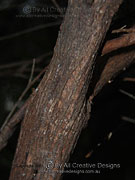

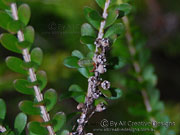
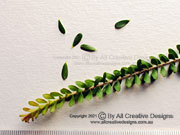
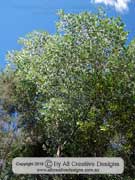


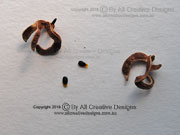
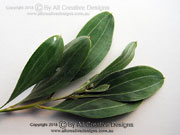
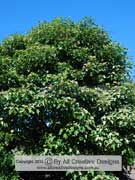

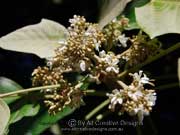
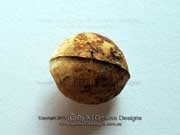
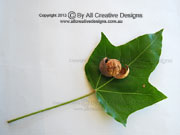
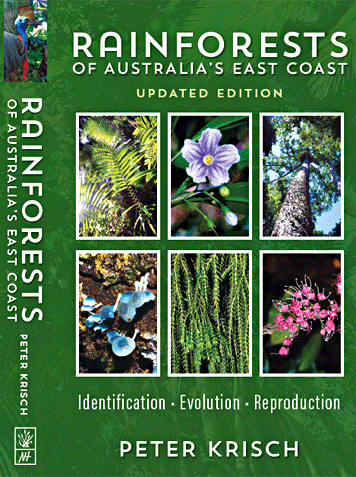
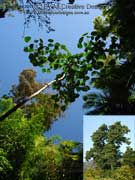


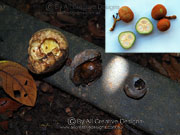
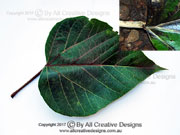
tn.jpg)


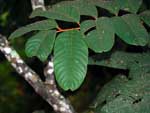
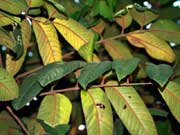

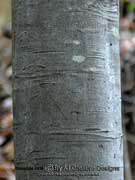
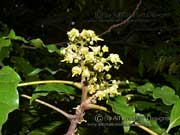
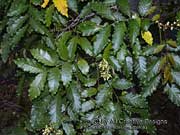
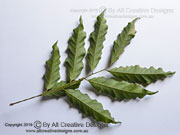
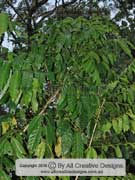

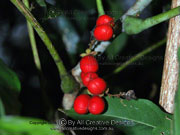
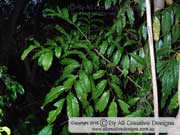
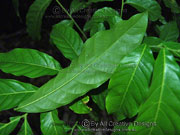
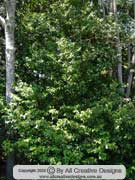


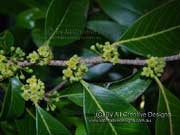
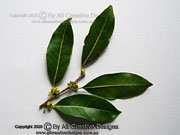
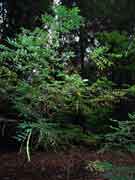
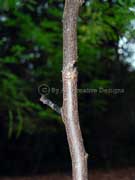
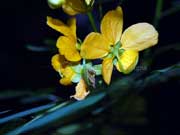

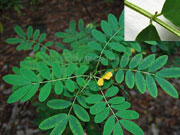


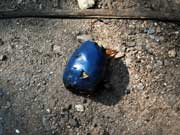

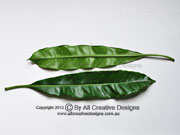

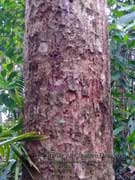
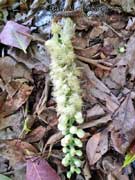
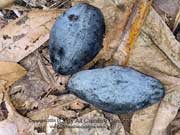
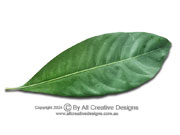
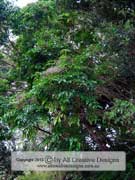
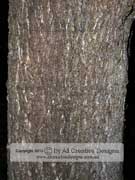
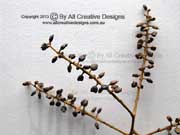

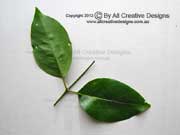
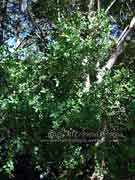

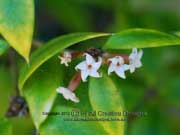
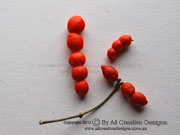
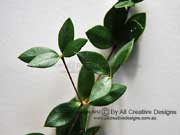

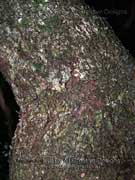
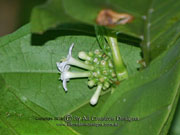


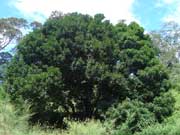
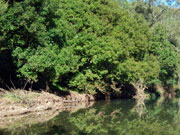


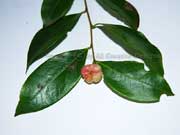
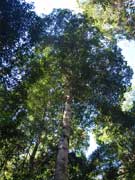

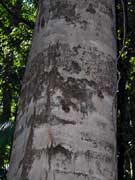
tn.jpg)



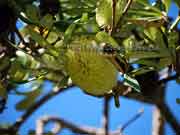
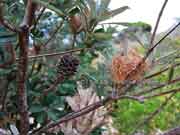
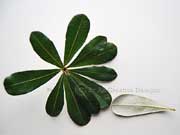
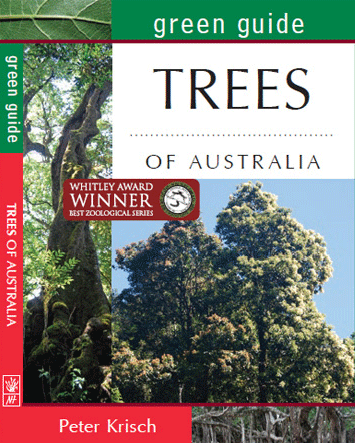
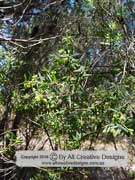
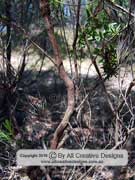
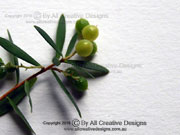

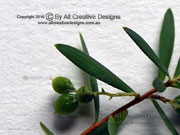
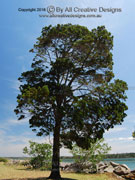
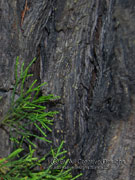




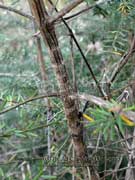
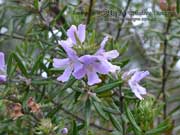

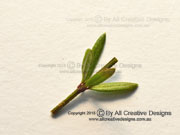
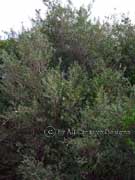
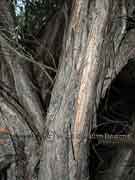
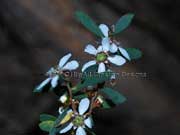
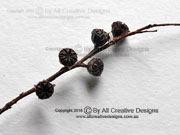
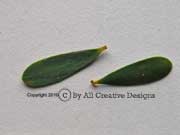
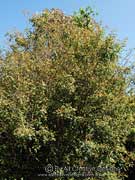

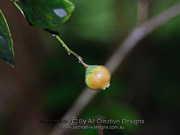
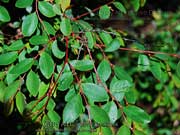
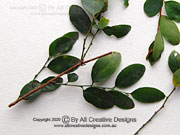
tn.jpg)

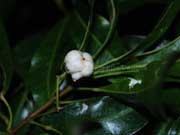
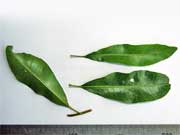
tn.jpg)

tn.jpg)
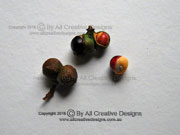
tn.jpg)

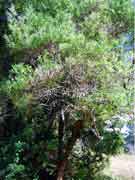

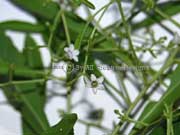
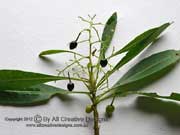


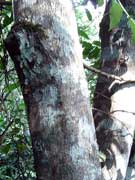
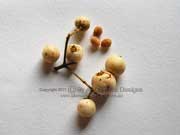


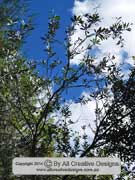
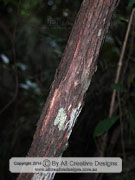
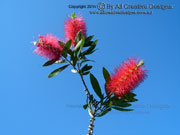


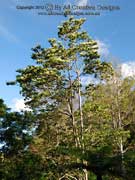
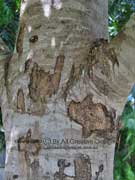
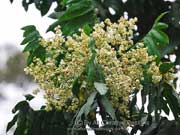
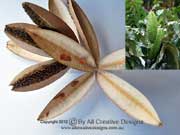


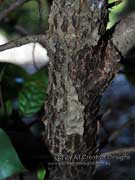
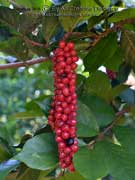
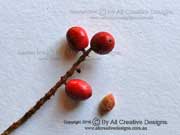
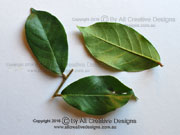
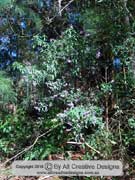
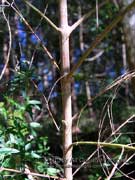
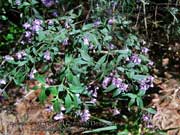

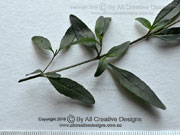
tn.jpg)
